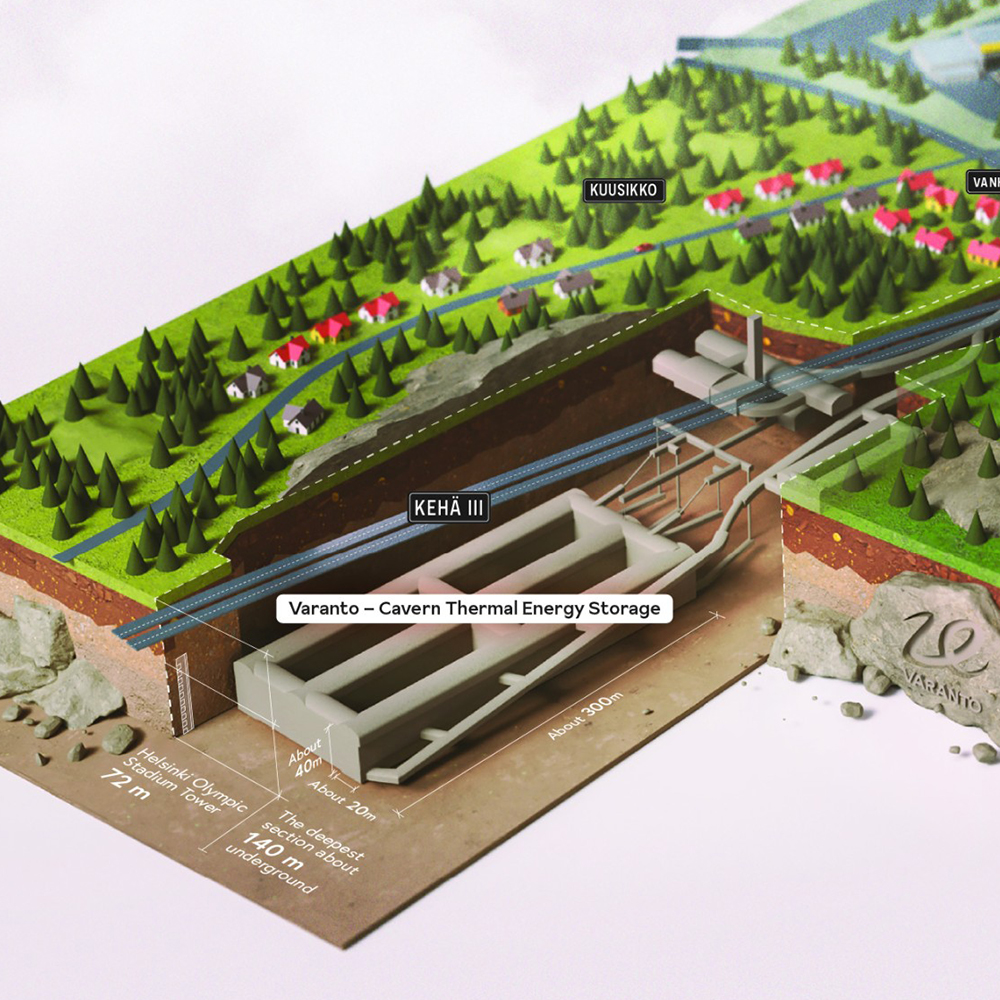-
Finland to Build the World’s Largest Subterranean Energy Storage System
Finland has initiated the construction of an underground thermal energy storage facility, located 100 meters beneath the surface, capable of supplying energy to a city of medium size.
As the adoption of renewable energy accelerates globally, focus is increasingly on enhancing efficiency and developing robust energy storage solutions to ensure a dependable supply. Existing technologies include water reservoirs, compressed air storage, and large-scale batteries. However, Finland is pioneering an innovative underground thermal storage approach with significant potential for the energy transition. This system can store up to 90 GWh of energy from renewable sources.
What will I read in this article?
Energy storage caverns
To grasp this initiative, one must first understand the nuances of Finland’s energy system. In cities like Vantaa, extensive networks of pipelines distribute hot water to household heat exchangers, heated by industrial waste heat and thermal power plants. The aim, however, is to shift towards storing heat derived from renewable sources, like summer solar energy, to achieve carbon neutrality by 2030.
Slated to start construction in 2024, the project involves three vast underground caverns, each 300 meters long, 40 meters high, and 20 meters wide, capable of storing over one million cubic meters of water at depths reaching 140 meters. This depth maintains the water under sufficient pressure to heat up to 140°C without vaporizing.

During summer and periods of low electricity costs, these caverns will be filled with water heated by two 60 MW electric boilers powered by renewable sources. Once fully operational, the system can deliver up to 60 GWh, enough to sustain a medium-sized Finnish city for a year or to charge 1.3 million electric vehicles, according to the public company behind the project. All these factors will make it the largest storage facility of its kind in the world.
Moreover, the project will incorporate AI-controlled systems to manage the inflow and outflow of hot water year-round, optimizing resource use. The project developers note that, besides lowering emissions, the energy store will help stabilize consumer prices.
With an estimated investment of 200 million euros, the Vantaa thermal energy storage complex is expected to commence operations in 2028.
Megabatteries: The future of energy storage
Megabatteries represent today’s most versatile and scalable energy storage solution. Typically using lithium-ion technology, they store power generated by solar and wind facilities, ensuring availability anytime, regardless of weather conditions. For example, the Cunningham battery farm in Texas can store 380 MWh on a six-hectare site.
This technology offers numerous benefits, including consistent energy supply, capacity to meet peak demands, and reduced investment in energy infrastructure. For more insights into megabatteries as an energy storage solution, we recommend this article for a detailed analysis.
The era of waste heat
The Finnish endeavor is just one of many initiatives leveraging thermal energy in urban settings. Another significant area of focus is sewage systems, substantial energy consumers. Daily activities such as showering or using washing machines send hundreds of liters of hot water down the drain.
This energy is reclaimable through a method known as Sewage Heat Recovery (SHR), used either to generate electricity or provide heating, aiding the shift towards a fully renewable power system. The process involves passing hot wastewater through heat exchangers, which transfer the heat without direct contact with the secondary fluid, then redistributing the heated water to homes via a pipeline network. This method doesn't store energy but maximizes the energy initially used to heat the water.
One notable example is a pilot project in Vancouver, Canada, where over 6,000 apartments are heated using recovered waste heat, saving up to 80% of the energy. Other cities like Chicago are also expected to adopt SHR technologies soon, not just for heating homes but also for public swimming pools, as seen in Raalte, Netherlands.
Sources:
Imágenes:
- Vantaan Energia
Write your comment
All fields are mandatory.
Thank you for your comment
More about Energy
Featured topics
Read the most discussed articles

{{CommentsCount}} Comments
Currently no one has commented on the news.
Be the first to leave a comment.
{{firstLevelComment.Name}}
{{firstLevelComment.DaysAgo}} days ago
{{firstLevelComment.Text}}
Answer{{secondLevelComment.Name}}
{{secondLevelComment.DaysAgo}} days ago
{{secondLevelComment.Text}}